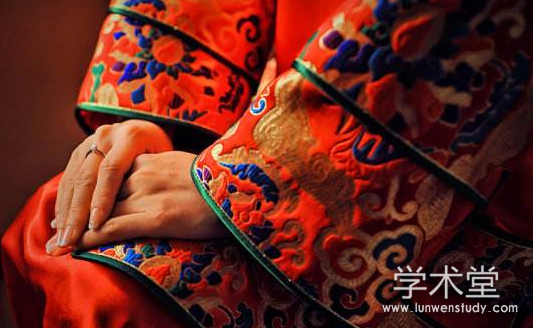摘 要
民间缠花是用彩色丝线缠绕人造或实物胚架而制成的工艺美术品,隶属于中国民间美术,常用于民俗庆典。缠花传承仅限于师徒口耳相传或家族传授,集合了水墨画、剪纸、立体刺绣等工艺的显着特点,是民间独特的一种手工技艺。缠花制作材料简单而日常,由各色丝线、纸样、铜丝为主。缠花制作需双手配合,用丝线紧密缠绕出色彩变化丰富、造型逼真的鱼、虫、花、鸟、兽、果、汉字等。民间缠花以体积小、构思巧、工艺精致、造型鲜活为审美特征。
英山缠花是湖北省非物质文化遗产保护项目,源于宋代,兴起于明清,盛于民国,曾是民间习俗庆典中的主角,在“婚、生、嫁、娶”中扮演重要角色,不同的作品分别蕴含了不同的吉祥寓意。除此以外,在我国福建省厦门洪厝村和台湾台中、鹿港、宜兰等地亦有类似工艺,当地人们称其为“春仔花”或者“闽南缠花”。随着历史的发展、生活习俗的改变以及民族的迁移,缠花传承人年岁已高,缠花技艺濒临消失,抢救性保护工作迫在眉睫。笔者自 2015 年参与非物质文化遗产的传承与保护过程中,了解到民间缠花传承面临的瓶颈是传承人的生存环境问题、创新模式问题以及传统工艺保护等方面的问题,力求为缠花探索更加有效的活态传承路径。
通过对民间缠花的历史起源、文化内涵、技艺特点、传承现状等调研资料整理分析,对比湖北、福建、台湾三地缠花的制作工艺、材料运用、造型特点、色彩选择以及创新应用五个方面进行深入研究。经多次手工制作实验得到的结果,分析如何提高制作效率,且保证缠花耐用而美观的方法。并经过问卷调查,具中式特色的民间工艺在婚嫁服中深受年轻一代人们的喜爱。笔者在保持缠花原汁原味的技艺基础上,从造型、文化、技艺、配色等方面进行与现代时尚婚嫁服饰结合的研究,让缠花以新式样的设计走向华丽而时尚的舞台。
关键词:民间缠花;活态传承;婚嫁服饰;工艺制作:线艺材料。
Abstract
Folk Chan-hua is a handcraft made from artificial or real embryo frame with colored threads intertwined,which attaches to Chinese folk art and is usually used in traditional celebrations. The Chan-hua is a unique folkcraft that has the salient features of the wash painting, paper-cut, three-dimensional embroidery and othertechniques and it’s only inherited by word of mouth or family. The construction materials mainly include kindsof threads, patterns and copper wires which are simple and daily. It need be finished with double handscoordination so that the threads are closely intertwined to make the fish, insects, flowers, birds, animals, fruitand Chinese characters with colorful and realistic shape. It is highly valued with the characteristics of small size,clever idea, exquisite craftsmanship and fresh shape.

Chan-hua of Yingshan in Hubei Province is an immateriality culture protection heritage project, originatedin the Song Dynasty, rising in the Ming and Qing dynasties, flourishing in the Chinese Republic. It was once themain role in the folk traditional celebrations, and played an important role in "marriage, birth, marriage andmarriage" with different auspicious meaning in different works. In addition, there are similar crafts in HongcuoVillage, Xiamen, Fujian Province, and Taichung, Lugang and Ilan in Taiwan, where people call them "Chun ZaiHua" or "Min Chan-hua". With the development of history, the change of living customs and the migration ofthe nation, its inheritors get old and the craft is at risk of vanishing so that the rescue and protection efforts isat all imminent. Since participating in inheritance and protection of intangible heritagethe in 2015, the authorrealizes that the bottlenecks faced by the inheritance of folk Chan-hua are the survival environment of theinheritor, the innovation models and the protection of traditional craft, etc. and strive to find a more effectiveway to inherit it as living folk culture.
This paper researched and analyze by means of comparing the historical origin, cultural connotation,technical characteristics and inheritance status of folk Cha-hua. And it also study deeply by means of comparingthe five aspects of the production technology, material application, model characteristics and color selection inHubei, Fujian and Taiwan. After many manu-experiments, this paper analyzes how to improve the productionefficiency and make it durable and beautiful. And by means of questionnaire survey, it is found that the folkcraftsmanship with Chinese characteristics is deeply loved by the younger generation in the wedding dress. Theauthor, on the basis of maintaining the true flavor of the flowers, studies the combination of the styling, culture,technique and color matching with the modern fashion wedding dress, so that the Cha-hua with new designcould go down to the gorgeous and fashionable stage.
Key words:Folk Chan-hua; dynamic heritage; wedding dress; process technology; Line artand material
目 录
1 绪论
1.1 课题研究的背景
1.2 课题研究的目的和意义
1.2.1 研究目的
1.2.2 研究意义
1.3 国内外研究现状
1.3.1 国内研究现状
1.3.2 国外研究现状
1.4 课题研究方法和路线
1.4.1 文献研究法
1.4.2 问卷调查法
1.4.3 口述记录法
1.4.4 探索性研究法
1.4.5 研究路线
2 传统民间缠花概述
2.1 传统民间缠花的起源
2.2 传统民间缠花的用途
2.2.1 婚嫁装饰用途
2.2.2 庆生寿宴用途.
2.2.3 祭祀用途.
2.3 传统民间缠花的工艺制作.
2.3.1 传统民间缠花的制作材料.
2.3.2 传统民间缠花的制作技巧.
2.4 民间缠花的分布状况及特征.
2.4.1 英山缠花特征.
2.4.2 闽南缠花特征.
2.4.3 台湾缠花特征.
3 婚嫁服中传统设计元素的现状与趋势.
3.1 婚嫁服中传统设计元素的现状.
3.1.1 传统图案元素的运用.
3.1.2 传统面料的运用.
3.1.3 传统手工技艺的运用.
3.1.4 传统服装结构的运用.
3.2 婚嫁服中传统设计元素的趋势.
3.2.1 以中西合璧为主流.
3.2.2 以定制模式为潮流.
4 缠花婚嫁服设计方法与技术处理研究.
4.1 缠花婚嫁服饰的组合设计技巧.
4.1.1 多变的组合形式.
4.1.2 拆分与组合设计.
4.2 缠花婚嫁服装饰部位分析.
4.2.1 禁忌装饰部分.
4.2.2 适合装饰部分.
4.3 缠花婚嫁服中缠花纹样技术处理.
4.3.1 立体装饰处理.
4.3.2 半立体装饰处理.
4.3.3 纹样破型工艺处理.
5 缠花婚嫁服饰的设计实践.
5.1 《花鸟卷》设计构思.
5.1.1 设计灵感与来源.
5.1.2 色彩选择.
5.1.3 线料选择.
5.2 《花鸟卷》设计与制作.
5.2.1 缠花样式设计.
5.2.2 服装完美视觉效果探析.
5.2.3 设计效果图展示.
6 结论.
参考文献.